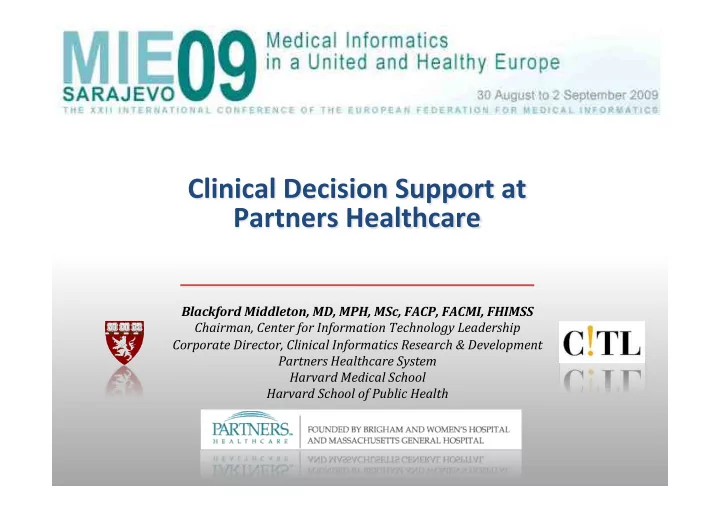

Blackford Middleton, MD, MPH, MSc, FACP, FACMI, FHIMSS Chairman, Center for Information Technology Leadership Corporate Director, Clinical Informatics Research & Development Partners Healthcare System Harvard Medical School Harvard School of Public Health
What is Clinical Decision Support? The Evidence For and Against CDS Current examples and R&D Projects from Partners The Clinical Decision Support Consortium
“What information consumes is rather obvious: it consumes the attention of its recipients. Hence a wealth of information creates a poverty of attention, and a need to allocate that attention efficiently among the overabundance of information sources that might consume it.” Changing clinician roles: From Omniscient Oracle… to Knowledge Broker.
acted upon analyzed compiled After B Blum, 1984
Medical literature doubling every 19 years Doubles every 22 months for AIDS care 2 Million facts needed to practice Covell study of LA Internists: 2 unanswered clinical questions for every 3 pts • 40% were described as questions of fact, • 44% were questions of medical opinion, • 16% were questions of non‐medical information. Covell DG, Uman GC, Manning PR. Ann Intern Med. 1985 Oct;103(4):596-9
Generally, with direct observation, or interview immediately after clinical encounters, physicians have approximately one question for every 1‐2 patients Independent estimates: 0.6, and 0.62 Q/pt Holds across PCP and specialty care Holds across urban and rural Gorman, 1995 Gorman and Helfand 1995
An objective measure of the amount of literature generated by medical scientists annually
Original research 18% Negative variable results Dickersin, 1987 Submission 46% 0.5 year Kumar, 1992 17 years to apply 14% of Koren, 1989 Acceptance Negative 0.6 year results research knowledge Kumar, 1992 Publication 17:14 to patient care! 35% 0.3 year Poyer, 1982 Balas, 1995 Lack of Bibliographic databases numbers 50% 6. 0 13.0 years Antman, 1992 Poynard, 1985 Reviews, guidelines, textbook 9.3 years Inconsistent indexing Patient Care Balas Yearbook Medical Informatics 2000gtre4, courtesy M Overhage
"...The curse of medical education is the excessive number of schools. The situation can improve only as weaker and superfluous schools are extinguished." “Society reaps at this moment but a small fraction of the advantage which current knowledge has the power to confer.” Abraham Flexner, Medical Education in the United States and Canada. Boston: Merrymount Press, 1910
“Instead of teaching doctors to be intelligent map readers, we have tried to teach every one to be a cartographer.” “We practice healthcare as if we never wrote anything down. It is a spectacle of fragmented intention.” Larry Weed, M.D. (father of “S.O.A.P.” note)
Prone to error Lots of information but no data Limited decision support, or quality measurement Does not integrate with eHealthcare Will not transform healthcare
Medical error, patient safety, and quality issues 98,000 deaths related to medical error 40% of outpatient prescriptions unnecessary Patients receive only 54.9% of recommended care Fractured healthcare delivery system Medicare beneficiaries see 1.3 – 13.8 unique providers annually, on average 6.4 different providers/yr Patient’s multiple records do not interoperate An ‘unwired’ system 90% of the 30B healthcare transactions in the US every year are conducted via mail, fax, or phone
“…driven primarily by local norms that tend towards heavier TEXAS use of discretionary services – El Paso such as diagnostic testing and surgical versus less invasive interventions – for which there are no clear clinical guidelines.” 790 mi., Peter Orszag, OMB Blog 1271 km http://www.whitehouse.gov/omb/ blog/ McAllen http://tr.im/sVLA
“A knowledge‐based system is an AI program whose performance depends more on the explicit presence of a large body of knowledge than on the presence of ingenious computational procedures…” Duda RO, Shortliffe EH. Expert systems research. Science. 1983 Apr 15;220(4594):261-8.
Algorithmic Inference Engine Statistical Pattern Matching Knowledge Base Rule‐based (Heuristic) Meta‐heuristic Fuzzy sets Neural nets Bayesian
A B Blois MS. Clinical judgment and computers. N Engl J Med. 1980 Jul 24;303(4):192‐7.
Formatting Results review, “pocket rounds” reports Interpreting EKG, PFTs, Pap, ABG Consulting QMR, DxPlain, Iliad, Meditel, Abd Pain, MI risk Monitoring Alerts: Critical labs, ABx/Surgery, ADEs Critiquing Vent mgmt, anesthesia mgmt, HTN Rx, Radiology test selection, Blood products ordering Kuperman GJ et al. J Hlth Info Mgmt (13)2, pg 81-96
CDS yields increased adherence to guideline‐based care, enhanced surveillance and monitoring, and decreased medication errors (Chaudhry et al., 2006) CDS, at the time of order entry in a computerized provider order entry system can help eliminate overuse, underuse, and misuse. (Bates et al., 2003; Austin et al., 1994; Linder, Bates and Lee, 2005; Tierney et al., 2003) For expensive radiologic tests and procedures this guidance at the point of ordering can guide physicians toward ordering the most appropriate and cost effective, radiologic tests. (Bates et al., 2003; Khorasani et al., 2003) Showing the cumulative charge display for all tests ordered, reminding about redundant tests ordered, providing counter‐detailing during order entry, and reminding about consequent or corollary orders may also impact resource utilization (Bates and Gawande, 2003; Bates, 2004; McDonald et al., 2004).
Savings potential: $44 billion reduced medication, radiology, laboratory, and ADE‐related expenses Advanced CDS systems Savings potential only with advanced CDS cost five times as much as basic CDS generate 12 times greater financial return A potential reduction of more than 2 million adverse drug events (ADEs) annually http://www.citl.org Johnston et al., 2003
Han YY (Pediatrics 116:6, Dec 2005) Analyzed data 13 prior, and 5 months post, implementation of CPOE in critical care Pre CPOE mortality rate 2.8%, Post 6.57% 3.28 Odds ratio after multivariate analysis adjusting for covariates Conclusion Order delay due to lack of pre‐register Up front time cost to enter orders Nurses away from bedside, at computer Altered interactions between ICU team members Delayed pharmacy administration Problems with order timing (subsequent doses)
Information Errors HCI/Workflow Errors Assumed dose Patient selection Med d/c failure Med selection Procedure‐linked med error Unclear log on/off Give now, and prn d/c error Meds after surgery Antibiotic renewal Post surgery suspended meds Diluent option error Time/data loss when CPOE down Allergy display Med delivery error Conflict or duplicate med Timing errors Delayed nursing documentation Rigid system design Koppel R et al. JAMA 293:10, Mar 2005
Recommend
More recommend